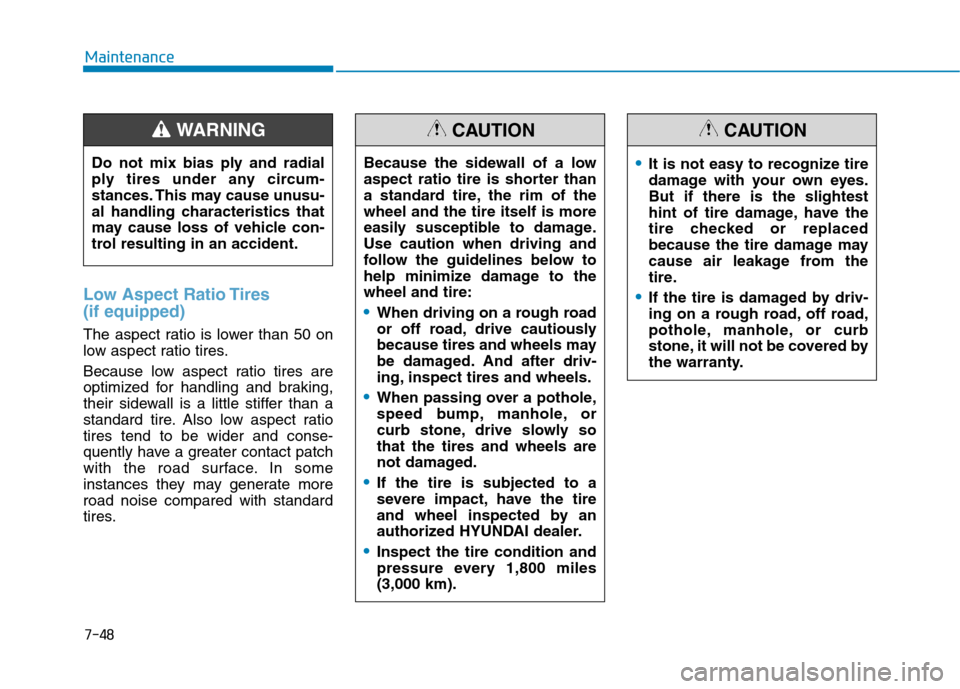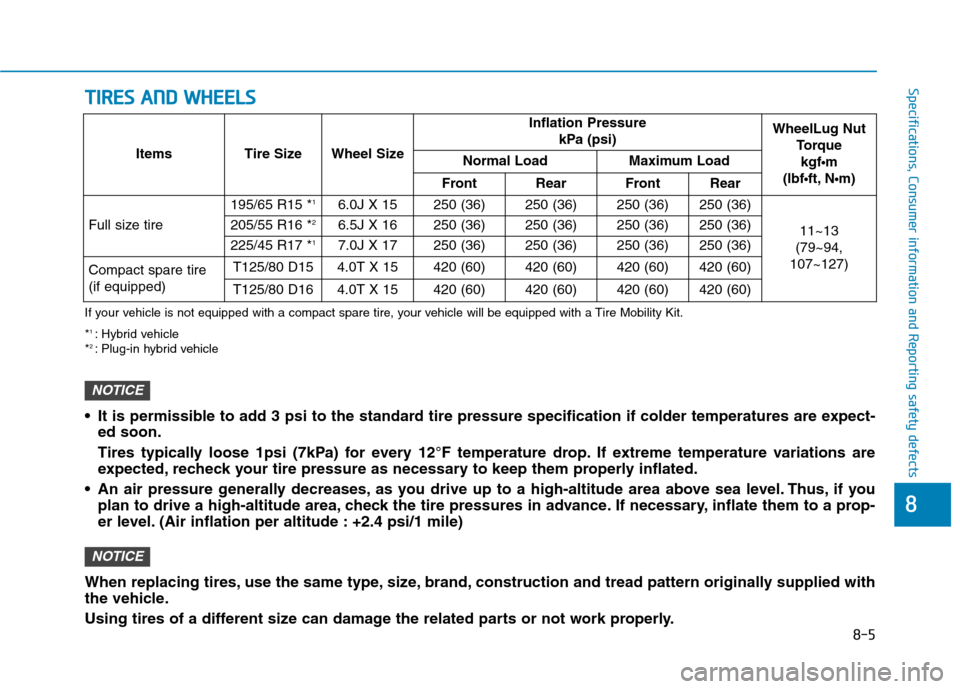Page 528 of 635

7-48
Maintenance
Low Aspect Ratio Tires
(if equipped)
The aspect ratio is lower than 50 on
low aspect ratio tires.
Because low aspect ratio tires are
optimized for handling and braking,
their sidewall is a little stiffer than a
standard tire. Also low aspect ratio
tires tend to be wider and conse-
quently have a greater contact patch
with the road surface. In some
instances they may generate more
road noise compared with standard
tires.Do not mix bias ply and radial
ply tires under any circum-
stances. This may cause unusu-
al handling characteristics that
may cause loss of vehicle con-
trol resulting in an accident.
WARNING
Because the sidewall of a low
aspect ratio tire is shorter than
a standard tire, the rim of the
wheel and the tire itself is more
easily susceptible to damage.
Use caution when driving and
follow the guidelines below to
help minimize damage to the
wheel and tire:
When driving on a rough road
or off road, drive cautiously
because tires and wheels may
be damaged. And after driv-
ing, inspect tires and wheels.
When passing over a pothole,
speed bump, manhole, or
curb stone, drive slowly so
that the tires and wheels are
not damaged.
If the tire is subjected to a
severe impact, have the tire
and wheel inspected by an
authorized HYUNDAI dealer.
Inspect the tire condition and
pressure every 1,800 miles
(3,000 km).
CAUTION
It is not easy to recognize tire
damage with your own eyes.
But if there is the slightest
hint of tire damage, have the
tire checked or replaced
because the tire damage may
cause air leakage from the
tire.
If the tire is damaged by driv-
ing on a rough road, off road,
pothole, manhole, or curb
stone, it will not be covered by
the warranty.
CAUTION
Page 560 of 635

888
Specifications & Consumer information
8
Specifications, Consumer information and Reporting safety defects
8
Dimensions ..............................................................8-2
Engine ......................................................................8-2
Bulb Wattage ..........................................................8-3
Tires and Wheels ...................................................8-5
Volume and Weight ................................................8-6
Air Conditioning System........................................8-6
Recommended Lubricants and Capacities ..........8-7
Recommended SAE Viscosity Number .........................8-8
Vehicle Identification Number (VIN) ...................8-9
Vehicle Certification Label....................................8-9
Tire Specification and Pressure Label .............8-10
Engine Number .....................................................8-10
Refrigerant Label .................................................8-10
Consumer Information .........................................8-11
Reporting Safety Defects ...................................8-12
Page 564 of 635

T TI
IR
RE
ES
S
A
AN
ND
D
W
WH
HE
EE
EL
LS
S
8-5
88
Specifications, Consumer information and Reporting safety defects
If your vehicle is not equipped with a compact spare tire, your vehicle will be equipped with a Tire Mobility Kit.
Items Tire SizeWheel Size
Inflation Pressure
kPa (psi)WheelLug Nut
Torque
kgf
•m
(lbf
ft, Nm)
Normal LoadMaximum Load
FrontRearFrontRear
Full size tire
195/65 R15 *16.0J X 15250 (36)250 (36)250 (36)250 (36)
11~13
(79~94,
107~127)205/55 R16 *26.5J X 16250 (36)250 (36)250 (36)250 (36)
225/45 R17 *17.0J X 17250 (36)250 (36)250 (36)250 (36)
Compact spare tire
(if equipped)T125/80 D154.0T X 15420 (60)420 (60)420 (60)420 (60)
T125/80 D164.0T X 15420 (60)420 (60)420 (60)420 (60)
It is permissible to add 3 psi to the standard tire pressure specification if colder temperatures are expect-
ed soon.
Tires typically loose 1psi (7kPa) for every 12°F temperature drop. If extreme temperature variations are
expected, recheck your tire pressure as necessary to keep them properly inflated.
An air pressure generally decreases, as you drive up to a high-altitude area above sea level. Thus, if you
plan to drive a high-altitude area, check the tire pressures in advance. If necessary, inflate them to a prop-
er level. (Air inflation per altitude : +2.4 psi/1 mile)
NOTICE
When replacing tires, use the same type, size, brand, construction and tread pattern originally supplied with
the vehicle.
Using tires of a different size can damage the related parts or not work properly.
NOTICE
*1 : Hybrid vehicle
*2 : Plug-in hybrid vehicle
Page 634 of 635

I-8
Theft-alarm system .........................................................3-13
Tire Pressure Monitoring System (TPMS) .....................6-14
Changing a Tire with TPMS ......................................6-18
Check Tire Pressure....................................................6-14
Low Tire Pressure LCD Display with
Position indicator .....................................................6-16
Low Tire Pressure Telltale..........................................6-16
Tire Pressure Monitoring System...............................6-15
TPMS Malfunction Indicator .....................................6-17
Tire specification and pressure label ..............................8-10
Tires and wheels ......................................................7-34, 8-5
All Season Tires .........................................................7-47
Check Tire Inflation Pressure .....................................7-36
Low Aspect Ratio Tires ..............................................7-48
Radial-Ply Tires ..........................................................7-47
Recommended Cold Tire Inflation Pressures.............7-35
Snow Tires ..................................................................7-47
Summer Tires .............................................................7-47
Tire Care .....................................................................7-34
Tire Maintenance ........................................................7-40
Tire Replacement........................................................7-38
Tire Rotation...............................................................7-37
Tire Sidewall Labeling ...............................................7-40
Tire Terminology and Definitions ..............................7-44
Tire Traction ...............................................................7-39
Wheel Alignment and Tire Balance ...........................7-38Wheel Replacement....................................................7-39
Towing ............................................................................6-40
Emergency Towing.....................................................6-42
Removable Towing Hook...........................................6-41
Towing Service ...........................................................6-40
Trailer towing................................................................5-170
Trip computer (Hybrid vehicle) ....................................3-109
Trip Modes ...............................................................3-109
Trip computer (Plug-in hybrid vehicle) ........................3-114
Trip Modes ...............................................................3-114
Vehicle certification label .................................................8-9
Vehicle Identification Number (VIN) ...............................8-9
Vehicle load limit ..........................................................5-165
Tire Loading Information Label...............................5-166
Volume and weight ...........................................................8-6
Index
T
V